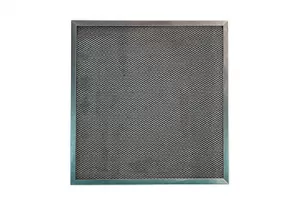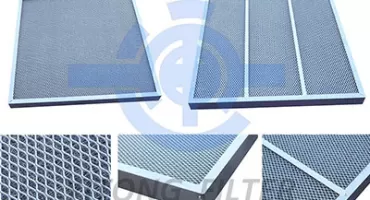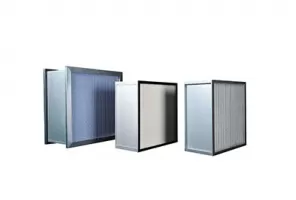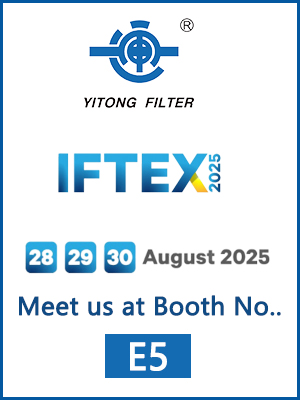 May 07, 2025
May 07, 2025
Indoor air quality matters more than ever. Whether you're running a hospital, office building, school, or even a residential complex, clean air is essential for health and comfort. One of the most effective ways to improve air quality in HVAC systems is through HEPA filtration. But what exactly is a HEPA filtration system, and how does it work in HVAC applications?
In this blog post, we’ll explain everything you need to know about HEPA filtration systems for HVAC, including how they work, where they’re used, and what benefits they offer.

HEPA stands for High Efficiency Particulate Air. A HEPA filter is designed to trap at least 99.97% of particles that are 0.3 microns in diameter. These particles include dust, pollen, mold spores, bacteria, and even some viruses.
HEPA filters are made from a dense mat of fibers, often made of fiberglass, arranged in a random pattern. As air flows through the filter, airborne particles are trapped using several physical mechanisms: diffusion, interception, and impaction.
In HVAC systems, HEPA filters are typically installed in air handling units (AHUs) or ductwork to clean the air before it reaches occupied spaces. They may be used in combination with pre-filters, which capture larger particles and help extend the life of the HEPA filter.
Pre-filter (e.g., MERV 8–13): Captures large particles like dust and lint.
HEPA Filter (H13 or H14 rated): Captures fine particles, including allergens and pathogens.
Fan or blower: Moves air through the filtration system.
Sealed housing: Ensures no air bypasses the filter.
In critical environments like hospitals and cleanrooms, HEPA filters are often used in terminal boxes or fan filter units (FFUs) placed close to the point of air delivery.
1. Improved Indoor Air Quality (IAQ)
HEPA filters remove harmful particles from the air, making indoor environments healthier. This is especially important for people with allergies, asthma, or respiratory conditions.
2. Protection Against Airborne Pathogens
HEPA filters can capture airborne viruses and bacteria, making them ideal for use in hospitals, labs, and public buildings.
3. Cleaner Equipment and Ductwork
By reducing particle buildup in HVAC components, HEPA filters help keep systems clean and running efficiently.
4. Regulatory Compliance
In some industries, like pharmaceuticals or healthcare, HEPA filtration is required to meet clean air standards such as ISO 14644 or ASHRAE guidelines.
HEPA filters are used in a wide range of HVAC systems, including:
Healthcare facilities: Hospitals, surgical suites, isolation rooms
Cleanrooms: Pharmaceuticals, electronics, biotechnology
Commercial buildings: Offices, malls, airports
Educational institutions: Schools, universities, labs
Residential homes: Especially for individuals with severe allergies
Many HVAC systems use MERV-rated filters, which range from MERV 1 to MERV 16. While MERV 13–16 filters can capture small particles, they don’t match the performance of true HEPA filters.
| Filter Type | Efficiency | Particle Size Range | Application |
|---|---|---|---|
| MERV 8 | ~70% | ≥3.0 microns | General buildings |
| MERV 13 | ~90% | ≥1.0 microns | Schools, offices |
| HEPA (H13) | ≥99.97% | ≥0.3 microns | Hospitals, cleanrooms |
If your goal is maximum air purity, HEPA is the gold standard.
While HEPA filters offer excellent filtration, there are some challenges:
1. High Air Resistance
HEPA filters are dense, which means air must be forced through them. This can strain HVAC systems not designed for such high resistance.
2. Higher Energy Use
Because of the added pressure drop, HVAC systems may consume more energy when using HEPA filters.
3. Retrofit Limitations
Not all existing HVAC systems can accommodate HEPA filters without modifications.
To overcome these challenges, consider consulting with a qualified HVAC professional. They can recommend whether to upgrade your system, add booster fans, or install standalone HEPA units.
Here are some key factors to consider:
Filter rating: Use certified H13 or H14 HEPA filters.
Size and fit: Ensure the filter fits properly in the housing to prevent air bypass.
Airflow capacity: Match the filter with your system’s airflow capabilities.
Sealing design: Look for gasket or gel-seal filters for critical environments.
Maintenance needs: Choose filters with longer life cycles to reduce replacement frequency.
Check pressure drop: Monitor pressure gauges or airflow sensors to detect clogging.
Inspect regularly: Visual checks can identify damage or bypass issues.
Replace on schedule: Follow manufacturer guidelines—typically every 6–12 months.
Use certified replacements: Always use filters from trusted manufacturers.
HEPA filtration systems are a powerful tool for improving indoor air quality in HVAC systems. They capture a wide range of airborne contaminants, making them ideal for healthcare, commercial, industrial, and even residential use.
While installing HEPA filters may require careful planning and sometimes HVAC upgrades, the benefits—cleaner air, healthier occupants, and regulatory compliance—are well worth the effort.
If you’re considering adding HEPA filters to your HVAC system, work with experienced professionals to ensure proper selection, installation, and maintenance.
Need help choosing the right HEPA filters for your HVAC system?
Contact our team today for expert advice and high-performance air filtration solutions.
 Jan. 09, 2025
Stainless Steel Cleanable Air Filters: A Durable and Sustainable Solution
Jan. 09, 2025
Stainless Steel Cleanable Air Filters: A Durable and Sustainable Solution
 Sep. 26, 2023
High Temp Pre-Filters Ordered by Indonesian Customers
Sep. 26, 2023
High Temp Pre-Filters Ordered by Indonesian Customers
The High Temp Pre-Filters ordered by the Indonesian customers have been shipped.
 Oct. 15, 2024
Industry Applications of H13 True HEPA Filters: Clean Air for Critical Environments
Oct. 15, 2024
Industry Applications of H13 True HEPA Filters: Clean Air for Critical Environments

